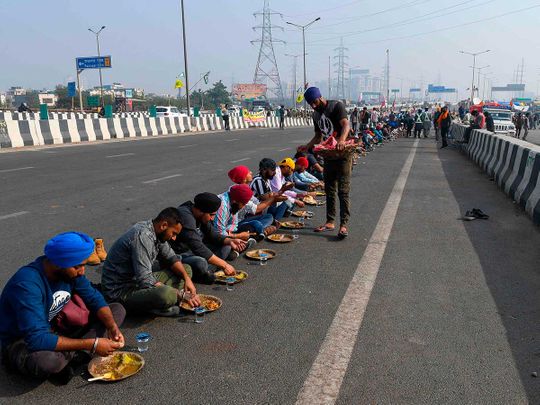
Now that the agitating farmers have got what they wanted, will they give the nation what it wants? Apparently not. The repeal of the farm laws does not seem to satisfy them. They have not stopped their protests and demands. They want more. What is more? It is nothing short of guaranteed minimum support price (MSP) for whatever the farmers produce.
But aren’t they already getting MSP? Yes, they are. But now want it by law. Right now, MSP is given by choice — by the government. Its beneficiaries are mostly richer wheat and paddy farmers of Punjab, Haryana, and Western Uttar Pradesh.
There are similar price guarantees for other crops, such as sugar cane, at times, even onion and oil seeds too. But these are measures taken by the government to regulate food supplies, to ensure there are no shortages, and minimise farmer suffering in times of calamity.
The British colonial administration never waived farm taxes. That is why, after a famine year, Sardar Vallabhbhai Patel, later independent India’s Deputy Prime Minister and Home Minister, launched the Kheda Satyagraha in 1918. Did the British relent? Not really. The farmers were practically destroyed, their properties seized and sold to new buyers to recover their dues, and the protesters were brought to the brink of starvation and destitution.
It was only after a series of negotiated parlays that the colonial administration waived the taxes for the famine year and protest year, when nothing could be sowed or reaped. Property sold and auctioned off was not returned, although the nationalists managed to persuade many of the new buyers to return it.
In those days, the most important colonial officer in rural areas was the Collector. He was called that because he collected taxes. In independent India, the name persists, unfortunately. But the District Collector today collects nothing. Instead, he helps in spending and distributing the governments funds on welfare and development. Indeed, farm income in India is tax free.
A serious anomaly
This has created a serious anomaly. While most of India’s estimated half-a-billion plus farmers and their dependents are poor, with smaller and smaller land holdings with each passing generation, there is a section of agriculturists which is quite well off. Some farmers are even rich. It is largely this section and its powerful allies that wants to institutionalise a regime of perpetual subsidies so that their tax-free income is guaranteed by the state and the taxpayers.
We have come a long way, indeed, from the times of the British Raj. Now the wheel has turned a full circle. The farmers, given their numbers and power as a vote bank, wish not only to block reforms, which will benefit the entire nation, but also hold the rest of the country to ransom by blocking roads, blockading the capital, semi-permanent shelters and buildings on occupied lands near the highways and entry points to the capital.
In my last column I argued that the repeal of farm laws is, more than anything else, a tactical retreat. Agricultural reforms are the need of the hour. They can be postponed, but not indefinitely. India is already behind in this area by two or three decades. From being an importer of food grains, oil seeds, and milk, India now produces surpluses and is a net exporter. But the entire food management regime of the country still reflects the scarcity and protectionist paradigm.
The Food Corporation of India (FCI) which buys, stores, and supplies food stocks is a heavily subsidised, inefficient, and leakage prone system. Corruption and mismanagement are endemic to it. Each year millions of tons of food rots in its godowns or is eaten by rats and vermin.
Supplies meant for the public distribution system are diverted or siphoned off by a well-oiled system of middlemen and racketeers, all, allegedly, with the blessings and to the advantage of the local political bosses. If fertiliser subsidies and other farm incentives, including direct benefits to registered farmers, are added, it is estimated that over 30% of India’s budget goes to the farm sector which does not contribute directly to the exchequer in terms of taxes.
Prosperity of India
Farm reforms coupled with farmer education and skilling are absolutely necessary for the future growth and prosperity of India. Prime Minister Narendra Modi knows this all to well.
But for him to bring back farm reforms in another package through other means depends of the success of his party, the BJP, at the hustings come February 2022. A complex series of political maneuvers and machinations must take place before agricultural reforms can be reintroduced, let alone implemented.
In the meanwhile, much of northern India continues to breathe bad air, part of which is because of stubble burning farmers. The machines for compacting the stubble, converting it to fuel pellets and reusable biomass lie in sheds in Punjab, waiting for the political will and administrative orders before they can be deployed.
Bought at taxpayers expense, they add to the bad money, appeasement write-offs, and governmental sops to one of India’s most powerful sections of the population and important sectors of the economy. Lying unused, they may become useless by next year, after this stubble-burning season.
Is there a silver lining? There is. The country at large has come to understand that something needs to be done urgently. Farm economics and farm politics do not mix well. For the former to thrive, the latter must take a back seat. Malign farm politics is not only bad for the farm sector, but for the whole country.
When will the reforms come? That, however, remains a burning question for now. In the meanwhile, the dark and polluting smoke from farm fires billows down to Delhi and red dots of fields of stubble set ablaze are clearly visible in images circulated by Nasa satellites from high above planet earth.









